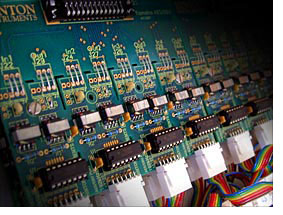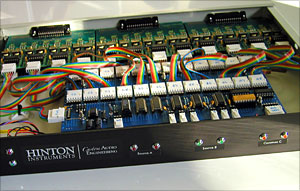 |
|
||||||||||||||||||||||||||||||||||||
 When the digital routing needs to be frequently changed or sent to multiple sources, active routing circuitry is necessary. This may be achieved with an unsynchronised or a synchronised system. When the digital routing needs to be frequently changed or sent to multiple sources, active routing circuitry is necessary. This may be achieved with an unsynchronised or a synchronised system.An unsynchronised system is basic electronic switching that does not check what signals are passing through it. When the routing is changed the signals are disrupted, and receiving devices are forced to resynchronise, resulting in severe clicks. Such a system may handle a mixture of different sample rate signals, but has no information of the signals it is switching. It is just a set of line receivers and drivers with logic level switching in between. A synchronised system locks to the studio word clock to which all digital audio devices are slaved. Routing changes are only made on sample word boundaries, resulting in no data corruption. There may still be clicks corresponding to the audio waveform change. The only way to eliminate these is to digitally crossfade the signals or to wait for common digital zero crossings, neither of which are feasible in a large system.
We can custom design and build a synchronised digital routing matrix system to suit your requirements using very similar technology our to proven MIDIX routing systems. Please enquire. |
|
|
|
All material on this website copyright © 2001-2007 Hinton Instruments |
|
Last updated: 2 June 2007
|

 Routing systems may offer translation to allow a mixture of different format devices, eg AES/EBU and TDIF. Sample rate conversion may also be incorporated.
Routing systems may offer translation to allow a mixture of different format devices, eg AES/EBU and TDIF. Sample rate conversion may also be incorporated.